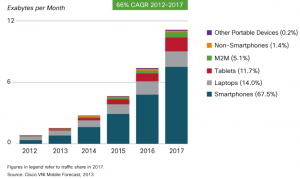Current Trends in Mobile Traffic
According to a report of CISCO recently published, the global mobile data traffic grew in 70 percent in 2012, besides this a significant growth is also expected for the next 5 years. CISCO identified the 10 major trends behind this growth of the mobile data traffic. We selected 5 of such trends that are closely connected with context-aware adaptation, summarized and briefly present them below:
- Device Diversification: although laptops generate most of the current traffic, smartphones and newer devices as tablets will also take a more significant proportion of the traffic in the near future. By 2017, CISCO estimates that there will be 8.6 billion handheld or personal mobile-ready devices and 1.7 billion machine-to-machine connections (e.g., GPS systems in cars, asset tracking systems in shipping and manufacturing sectors, or medical applications making patient records and health status more readily available). The proliferation of high-end handsets, tablets, and laptops on mobile networks is a major generator of traffic, because these devices offer the consumer content and applications not supported by previous generations of mobile devices.

- Growth in Average Traffic per Device: as mobile network connection speeds increase, consequently the average bit rate of content accessed through the mobile network is also expected to increase. Moreover, the shift toward on-demand video will affect mobile networks as much as it will affect fixed networks, and finally because the usage of mobile devices increase an individual’s contact time with the network, it is likely that this increased contact time will lead to an increase in overall minutes of use per user.
-
Impact of 4G Connections on the Increase: The explosion of mobile applications and phenomenal adoption of mobile connectivity
losing weight
by the end users summed with the need for optimized bandwidth management and network monetization fuels the growth of Global 4G deployments and adoption. Service Providers, around the world, are busy rolling out 4G networks to help them meet the growing end-user demand for more bandwidth, higher security and faster connectivity on the move
- User Applications Driving Mobile Data Consumption: With the increasing number of smartphones and tablets connected through mobile networks, more attention is naturally turned to data consumption trends impacting both end-users and service providers. End-users become increasingly knowledgeable about how their usage patterns can be tailored for highest efficiency—while still using the applications they want to use, where and when they want to use them. Service providers look to data usage trends in order to ensure real-time network performance optimization.
- The (Mobile) Internet of Things: Cellular communication between objects, machines, or sensors has led to the growth of M2M connections. These connections are in the form of home and office security and automation, smart metering and utilities, maintenance, building automation, automotive, healthcare and consumer electronics etc.M2M technologies are being used across a broad spectrum of industries.
In conclusion, the mobile data services become a necessity for many network users. The mobile voice service is already considered a necessity by most users and the mobile data, video, and TV services will also become an essential part of consumers’ lives. Used extensively by consumer as well as enterprise segments, mobility has proven to be transformational. Mobile subscribers are growing rapidly and bandwidth demand due to data and video is increasing. The next 5 years are projected to provide mobile video adoption in many parts of the world. Backhaul capacity must increase so mobile broadband, data access, and video services can effectively support consumer usage trends and keep mobile infrastructure costs in check.
This report is based on the original article published by CISCO, which is publicly available online.





-
Twitter
- No public Twitter messages.
-
All about Serenoa
-
Funded by the European Commission

-
tags
Adaptation adaptive UI ambient intelligence Android Android SDK browser Brussels CASFE conference consortium context context-aware adaptation context-awareness CSS E-book Reader EICS elderly Events Facebook Fragments API framework HTML5 industrial panel iPad journal LREC MBUI Meeting Mobile Mobile Apps Model-driven models newsletter paper presentation review Review Meeting Serenoa standardization touch-based interaction TV UI W3C Working Group workshop



